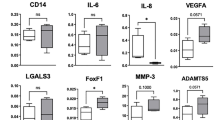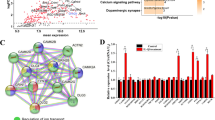Abstract
Various mechanical stresses can induce apoptosis of nucleus pulposus (NP) cells and intervertebral disc (IVD) degeneration in vivo, but the underlying molecular mechanism by which the number of NP cells is decreased in degenerated IVD is still not elucidated. The purpose of this study was to investigate whether the mitochondrial pathway is involved in compression-induced apoptosis of rabbit NP cells. The compression apparatus was used to investigate the effect of the compression in this process at one magnitude (1.0 MPa) for 6, 12, 18, 24 and 36 h. Cell viability was measured by cell counting kit-8. Apoptosis rate was analyzed by flow cytometry and the morphologic changes in apoptosis cells were observed by the phase-contrast microscopy and Hoechst 33258 staining. The apoptosis-related gene and protein synthesis, such as Bax, Bcl-2 and Caspase-3, was analyzed by real-time polymerase chain reaction and Western-blot, respectively. Mitochondrial function was evaluated by analyzing the mitochondrial permeability transition pore (MPTP), as well as reactive oxygen species (ROS) and mitochondrial membrane potential (MMP). The results indicated that compression at the magnitude of all time points induced apoptosis of rabbit NP cells in a time-dependent manner, and the cell viability was reduced significantly. Furthermore, the compression at this level profoundly suppressed the functions of the mitochondria such as the opening of MPTP, the excessive production of ROS and the decreased MMP. Our findings suggest that the compression-induced IVD degeneration is mediated, at least in part, via the mitochondrial apoptotic pathway in NP cells.









Similar content being viewed by others
References
Chen WH, Liu HY, Lo WC et al (2009) Intervertebral disc regeneration in an ex vivo culture system using mesenchymal stem cells and platelet-rich plasma. Biomaterials 30:5523–5533
Kalichman L, Hunter DJ (2008) The genetics of intervertebral disc degeneration. Familial predisposition and heritability estimation. Joint Bone Spine 75:383–387
Schultz DS, Rodriguez AG, Hansma PK et al (2009) Mechanical profiling of intervertebral discs. J Biomech 42:1154–1157
Zhao CQ, Wang LM, Jiang LS et al (2007) The cell biology of intervertebral disc aging and degeneration. Ageing Res Rev 6:247–261
Zhao CQ, Jiang LS, Dai LY (2006) Programmed cell death in intervertebral disc degeneration. Apoptosis 11:2079–2088
Setton LA, Chen J (2004) Cell mechanics and mechanobiology in the intervertebral disc. Spine 29:2710–2723
Aguiar D, Johnson SL, Osgema TR (1999) Notochordal cells interact with NP cells: regulation of proteoglycan synthesis. Exp Cell Res 246:129–137
Iwashina T, Mochida J, Miyazaki T et al (2006) Low-intensity pulsed ultrasound stimulates cell proliferation and proteoglycan production in rabbit intervertebral disc cells cultured in alginate. Biomaterials 27:354–361
Vonk LA, Kroeze RJ, Doulabi BZ et al (2010) Caprine articular, meniscus and intervertebral disc cartilage: an integral analysis of collagen network and chondrocytes. Matrix Biol 29:209–218
Hsieh AH, Twomey J (2010) Cellular mechanobiology of the intervertebral disc: new directions and approaches. J Biomech 43:137–145
Rannou F, Lee TS, Zhou RH et al (2004) Intervertebral disc degeneration: The role of the mitochondrial pathway in annulus fibrous cell apoptosis induced by overload. Am J Pathol 164:915–924
Zhao CQ, Liu D, Li H et al (2007) Interleukin-1β enhances the effect of serum deprivation on rat annular cell apoptosis. Apoptosis 12:2155–2166
Scott FL, Stec B, Pop C et al (2009) The Fas-FADD death domain complex structure unravels signaling by receptor clustering. Nature 457:1019–1022
Thornberry NA, Lazebnik Y (1998) Caspase: enemies within. Science 281:1312–1316
Wikstrom J, Twig G, Shirihai OS (2009) What can mitochondrial heterogeneity tell us about mitochondrial dynamics and autophagy. Int J Biochem Cell Biol 41:1914–1927
Lv L, Zhou ZX, Huang XZ et al (2010) Inhibition of peptidyl-prolyl cis/trans isomerase Pin1 induces cell cycle arrest and apoptosis in vascular smooth muscle cells. Apoptosis 15:41–54
Ott M, Gogvadze V, Orrenius S et al (2007) Mitochondria, oxidative stress and cell death. Apoptosis 12:913–922
Tripathy MK, Mitra D (2010) Differential modulation of mitochondria OXPHOS system during HIV-1 induced T-cell apoptosis: upregulation of Complex-IV subunit COX-II and its possible implications. Apoptosis 15:28–40
Haefen CV, Wendt J, Semini G et al (2011) Synthetic glycosidated phospholipids induce apoptosis through activation of FADD, caspase-8 and the mitochondrial death pathway. Apoptosis 16:636–651
Crawford N, Chacko AD, Savage KI et al (2011) Platinum resistant cancer cells conserve sensitivity to BH3 domains and obatoclax induced mitochondrial apoptosis. Apoptosis 16:311–320
Ravindran J, Gupta N, Agrawal M et al (2011) Modulation of ROS/MAPK signaling pathways by okadaic acid leads to cell death via, mitochondrial mediated caspase-dependent mechanism. Apoptosis 16:145–161
Qian Y, Du YH, Tang YB et al (2011) ClC-3 chloride channel prevents apoptosis induced by hydrogen peroxide in basilar artery smooth muscle cells through mitochondria dependent pathway. Apoptosis 16:468–477
Kaneyama S, Nishida K, Takada T et al (2008) Fas ligand expression on human nucleus cells decreases with disc degeneration process. J Orthop Sci 13:130–135
Park JB, Lee JK, Park EY et al (2008) Fas/FasL interaction of NP and cancer cells with the activation of caspases. Int Orthop 32:835–840
Hutton WC, Elmer WA, Boden SD et al (1999) The effect of hydrostatic pressure on intervertebral disc metabolism. Spine 24:1507–1515
Zucchini-Pascal N, Sousa GD, Rahmani R (2009) Lindane and cell death: at the crossroads between apoptosis, necrosis and autophagy. Toxicology 256:32–41
Zhou YJ, Zhang SP, Liu CW et al (2009) The protection of selenium on ROS mediated-apoptosis by mitochondria dysfunction in cadmium-induced LLC-PK1 cells. Toxicol In Vitro 23:288–294
Rodriguez-Enriquez S, He L, Lemasters JJ (2004) Role of mitochondria permeability transition pores in mitochondria autophagy. Int J Biochem Cell Biol 36:2463–2472
Lemasters J, Nieminen AL, Qian T et al (1998) The mitochondrial permeability transition in cell death: a common mechanism in necrosis, apoptosis and autophagy. Biochim Biophys Acta 1366:177–196
Reza A, Nicoll SB (2008) Hydrostatic pressure differentially regulates outer and inner annulus fibrosus cell matrix production in 3D scaffolds. Ann Biomed Eng 36:204–213
Wang DL, Jiang SD, Dai LY (2007) Biologic response of the intervertebral disc to static and dynamic compression in vitro. Spine 32:2521–2528
Wilke HJ, Neef P, Caimi M et al (1999) New in vivo measurements of pressures in the intervertebral disc in daily life. Spine 24:755–762
Ariga K, Yonenobu K, Nakase T et al (2003) Mechanical stress-induced apoptosis of endplate chondrocytes in organ-cultured mouse intervertebral discs. Spine 28:1528–1533
Wang JY, Baer AE, Kraus VB et al (2001) Intervertebral disc cells exhibit differences in gene expression in alginate and monolayer culture. Spine 26:1747–1752
Li Z, Jo J, Jia JM et al (2010) Caspase-3 activation via mitochondria is required for long-term depression and AMPA receptor internalization. Cell 141:859–871
Marzo I, Brenner C, Zamzami N et al (1998) Bax and adenine nucleotide translocator cooperate in the mitochondrial control of apoptosis. Science 281:2027–2031
Huang QR, Li Q, Chen YH et al (2010) Involvement of anion changer-2 in apoptosis of endothelial cells induced by high glucose through an mPTP-ROS-Caspase-3 dependent pathway. Apoptosis 15:693–704
Kroemer G, Pelit P, Zamzami N et al (1995) The biochemistry of programmed cell death. FASEB J 9:1277–1287
Crompton M (1999) The mitochondrial permeability transition pore and its role in cell death. Biochem J 341:233–249
Acknowledgments
This work was supported by a grant from National Natural Sciences Foundation of China (No. 30700841, 81171149). Special thanks go to the members of the IVD degeneration research team at the Institute of Orthopedic Surgery of Union Hospital, Tongji Medical College, Huazhong University of Science and Technology, the People’s Republic of China for their help.
Conflict of interest
Foundation funds were received in support of this work. No benefits in any form have been or will be received from a commercial party related directly or indirectly to the subject of this manuscript. The authors declare that they have no conflict of interest.
Author information
Authors and Affiliations
Corresponding author
Additional information
Fan Ding and Zeng-Wu Shao contributed equally to this work.
Rights and permissions
About this article
Cite this article
Ding, F., Shao, ZW., Yang, SH. et al. Role of mitochondrial pathway in compression-induced apoptosis of nucleus pulposus cells. Apoptosis 17, 579–590 (2012). https://doi.org/10.1007/s10495-012-0708-3
Published:
Issue Date:
DOI: https://doi.org/10.1007/s10495-012-0708-3




